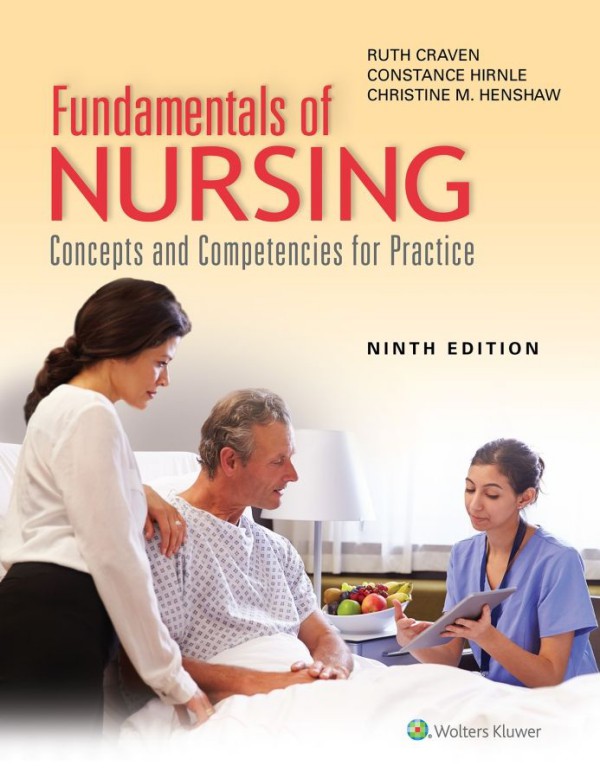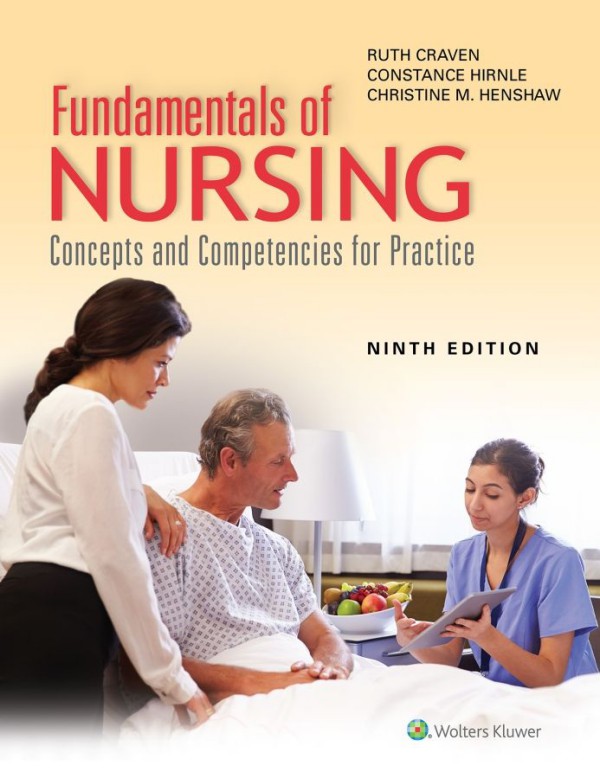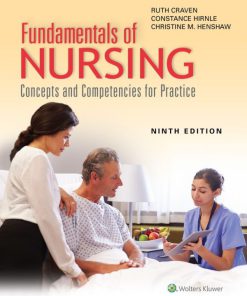Fundamentals of Nursing Concepts and Competencies for Practice 9th Edition by Ruth Craven, Constance Hirnle, Christine Henshaw ISBN 1975120426 9781975120429
$50.00 Original price was: $50.00.$25.00Current price is: $25.00.
Authors:Ruth F. Craven; Constance Hirnle; Christine Henshaw , Series:Nursing [94] , Author sort:Craven, Ruth F. & Hirnle, Constance & Henshaw, Christine , Languages:Languages:eng , Published:Published:Dec 2019 , Publisher:Wolters Kluwer Health
Fundamentals of Nursing Concepts and Competencies for Practice 9th Edition by Ruth Craven, Constance Hirnle, Christine Henshaw – Ebook PDF Instant Download/Delivery. 1975120426 ,9781975120429
Full download Fundamentals of Nursing Concepts and Competencies for Practice 9th Edition after payment
Product details:
ISBN 10: 1975120426
ISBN 13: 9781975120429
Author: Ruth Craven, Constance Hirnle, Christine Henshaw
Bring the principles of nursing to life and build a foundation for success from the classroom to the clinical setting. Fundamentals of Nursing: Concepts and Competencies for Practice, 9th Edition helps foster the strong critical thinking, clinical judgment, clear communication, and sound clinical skills students need to succeed throughout the nursing curriculum and to meet the challenges practicing nurses confront each day. Drawing from the latest clinical evidence, this big-picture approach breathes life into theoretical principles, putting students in the mindset of a successful nurse and immersing them in a proven nursing process framework that clarifies key capabilities, from promoting health to differentiating between normal function and dysfunction, to the use of scientific rationales and the approved nursing process.
This updated 9th Edition further enhances students’ clinical capabilities with new Unfolding Patient Stories that challenge students to think critically about commonly encountered patient scenarios. More than 850 online NCLEX®-style review questions, as well as NCLEX®-style review questions in the book, reinforce students’ test-taking confidence. New Critical Thinking Using QSEN Competencies features provide essential practice for applying concepts to clinical situations.
- NEW! Unfolding Patient Stories, written by the National League for Nursing, foster valuable reflection on commonly encountered clinical scenarios.
- UPDATED! Additional NCLEX® Review questions reinforce students’ exam readiness.
- NEW! Critical Thinking Using QSEN Competencies features include thought-provoking questions to boost students’ clinical reasoning and problem-solving capabilities.
- NEW!Revised organization of the Table of Contents reflects an updated focus on foundational nursing concepts
- and competencies.
- Case Scenarios at the beginning of each chapter encourage students to think holistically about common clinical situations.
- Richly illustrated concept maps help visual learners apply the nursing process and think critically about the chapter-opening case scenarios.
- PICO (patient/problem, intervention, comparison, outcome) displays guide students through a structured, evidence-based approach to finding answers to clinical challenges related to the chapter-opening case scenarios.
- Collaborating with the Healthcare Team displays familiarize students with the SBAR technique for effective interpersonal communication.
- Therapeutic Dialogues emphasize close listening and enhance students’ patient communication capabilities.
- Concept Mastery Alerts clarify potentially confusing topics as identified by Lippincott’s Adaptive Learning powered by PrepU.
- Apply Your Critical Thinking features encourage deep thinking on concepts and situations, with detailed answers in an appendix identifying areas for further review.
- Ethical-Legal Issues equip students to think critically about complex situations they may encounter.
- Plan of Care features help students apply available knowledge and evidence-based research to create effective care plans.
- Outcome-Based Teaching Plans guide students to specific patient education outcomes.
- NANDA-I Tables clearly outline the relationship between nursing diagnosis, outcomes and interventions.
- Safety Alerts highlight specific considerations for safe practice.
- Evidence-Based Bundles to Improve Patient Care recommend sets of evidenced-base practices to reliably improve patient outcomes.
- Key Terms lists familiarize students with essential vocabulary in each chapter.
- Learning Objectives alert students to the most important chapter concepts.
Fundamentals of Nursing Concepts and Competencies for Practice 9th Edition Table of contents:
Chapter 1: Introduction to Nursing
- The Role and Evolution of Nursing
- Nursing Theories and Their Impact on Practice
- The Nursing Process: An Overview
- The Four Major Concepts of Nursing: Person, Environment, Health, and Nursing
- The Role of the Nurse in the Healthcare System
- The Value of Compassionate and Patient-Centered Care
Chapter 2: Nursing Education, Professionalism, and Practice
- Pathways to Becoming a Nurse
- Nursing Licensure and Certification
- The Role of Nurses in Multidisciplinary Healthcare Teams
- Professionalism in Nursing Practice
- Ethical and Legal Considerations in Nursing
- The Future of Nursing: Trends, Innovations, and Challenges
Chapter 3: The Health Care Delivery System
- Overview of Health Care Systems and Services
- Types of Healthcare Providers and Facilities
- Nursing’s Role in Different Healthcare Settings
- The Influence of Health Policy on Nursing Practice
- Health Promotion and Disease Prevention Models
- Addressing Disparities in Healthcare
Chapter 4: Critical Thinking and Clinical Reasoning in Nursing
- The Importance of Critical Thinking in Nursing
- Developing Clinical Reasoning and Judgment Skills
- Applying the Nursing Process to Problem-Solving
- Tools for Enhancing Critical Thinking in Practice
- Clinical Decision-Making Models
- Addressing Cognitive Biases and Improving Clinical Accuracy
Chapter 5: Communication in Nursing Practice
- Effective Communication Skills for Nurses
- Therapeutic Communication Techniques
- Verbal and Nonverbal Communication
- The Role of Technology in Nursing Communication
- Communicating with Patients and Families
- Communication in Multidisciplinary Teams
Chapter 6: The Nursing Process
- The Five Phases of the Nursing Process
- Assessment: Gathering Patient Information
- Diagnosis: Identifying Patient Needs
- Planning: Setting Goals and Priorities
- Implementation: Carrying Out Nursing Interventions
- Evaluation: Assessing the Effectiveness of Care
Chapter 7: Caring and the Role of the Nurse
- The Concept of Caring in Nursing
- Building Therapeutic Relationships with Patients
- The Role of the Nurse in Holistic Care
- Providing Culturally Competent Care
- Ethical and Legal Issues in Caring
- Caring for the Whole Patient: Body, Mind, and Spirit
Chapter 8: Patient Safety and Quality Care
- The Importance of Patient Safety in Nursing Practice
- Preventing Healthcare-Associated Infections
- Medication Safety and Error Prevention
- Adverse Events, Root Cause Analysis, and Reporting
- Quality Improvement Initiatives in Nursing
- Using Evidence-Based Practice to Ensure Safe Care
Chapter 9: Health Promotion and Disease Prevention
- The Role of Nurses in Promoting Health
- Health Behavior Models and Theories
- Preventive Health Services and Screening
- Educating Patients on Healthy Lifestyles
- Addressing Health Disparities
- Working with Vulnerable Populations
Chapter 10: Infection Control and Prevention
- The Basics of Infection Control
- Standard Precautions and Transmission-Based Precautions
- Hand Hygiene and Personal Protective Equipment (PPE)
- Preventing Healthcare-Associated Infections (HAIs)
- Cleaning, Disinfecting, and Sterilizing Equipment
- The Role of Nurses in Infection Surveillance
Chapter 11: Legal and Ethical Aspects of Nursing
- Legal Aspects of Nursing Practice
- Ethical Principles and Decision Making in Nursing
- Informed Consent and Patient Autonomy
- Confidentiality and Patient Privacy (HIPAA)
- Legal Responsibilities in Nursing Practice
- Professional Boundaries and Nurse-Patient Relationships
Chapter 12: Cultural Competence in Nursing
- Understanding Cultural Competence in Healthcare
- Providing Culturally Sensitive and Safe Care
- The Role of Nurses in Reducing Health Disparities
- Cultural Humility and the Importance of Lifelong Learning
- Understanding Cultural Norms and Values
- Working with Diverse Populations in Global and Local Contexts
Chapter 13: Nursing Skills and Clinical Competencies
- The Role of Nursing Skills in Patient Care
- Basic Nursing Skills: Vital Signs, Medication Administration, and Hygiene
- Advanced Nursing Skills: Wound Care, Catheterization, and IV Therapy
- Assessing and Managing Pain
- Documentation and Charting in Nursing
- Using Technology and Simulation in Nursing Education
Chapter 14: Ethical Dilemmas and Professional Values in Nursing
- Defining Ethical Dilemmas in Nursing Practice
- Moral Distress and Ethical Decision-Making Frameworks
- The Nurse’s Role in Advocacy and Patient Rights
- Professional Values in Nursing Practice
- Applying Ethical Principles to Real-World Nursing Scenarios
Chapter 15: Nursing Care for Specific Populations
- Pediatric Nursing and Developmental Considerations
- Maternal and Newborn Nursing
- Geriatric Nursing and Age-Related Health Changes
- Mental Health Nursing and Therapeutic Approaches
- Palliative and End-of-Life Care
- The Role of Nurses in Caring for Families
Chapter 16: Pain Management
- Understanding Pain: Physiology and Psychology
- Types of Pain: Acute vs. Chronic
- Assessing Pain in Different Populations
- Pharmacological and Non-Pharmacological Pain Relief
- The Role of Nurses in Pain Management
- Legal and Ethical Considerations in Pain Management
Chapter 17: Fundamentals of Nursing Care for Common Health Problems
- Nursing Interventions for Respiratory, Cardiovascular, and Renal Disorders
- Managing Diabetes, Hypertension, and Other Chronic Conditions
- Preoperative and Postoperative Care
- Caring for Patients with Neurological Conditions
- Wound Care and Infection Management
Chapter 18: Nursing Care of the Family and Community
- The Family as a Unit of Care
- Family-Centered Nursing Practice
- Assessing Family Dynamics and Needs
- Community Health and Nursing Practice
- Health Education in the Community
- Public Health Nursing and Disease Prevention
Chapter 19: Leadership and Management in Nursing
- The Role of Leadership in Nursing
- Leadership Styles and Theories in Nursing
- Managing Care in Clinical Settings
- Delegation, Supervision, and Teamwork
- Conflict Resolution and Negotiation Skills
- The Nurse’s Role in Quality Improvement and Change Management
Chapter 20: The Future of Nursing
- Emerging Trends and Innovations in Nursing
- The Impact of Technology on Nursing Practice
- Continuing Education and Professional Development
- The Role of Nurses in Global Health
- Preparing for the Challenges of the Future in Healthcare
People also search for Fundamentals of Nursing Concepts and Competencies for Practice 9th Edition:
teaching and training concept and differences
what is competencies in lesson plan
most essential learning competencies in science 9
concept-development practice page 9-3
You may also like…
eBook PDF
Clinical Teaching in Nursing 1st edition by Ruth White,Christine Ewan 0748731695 9780748731695












